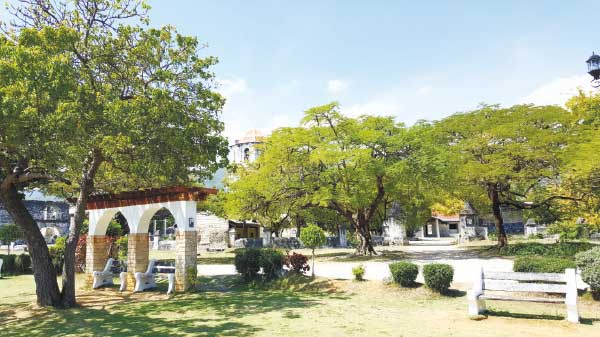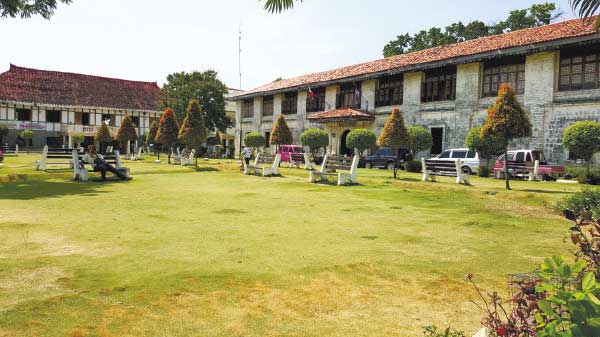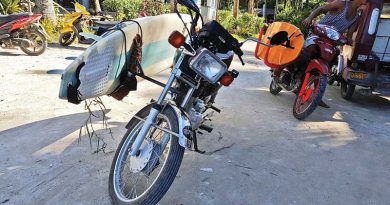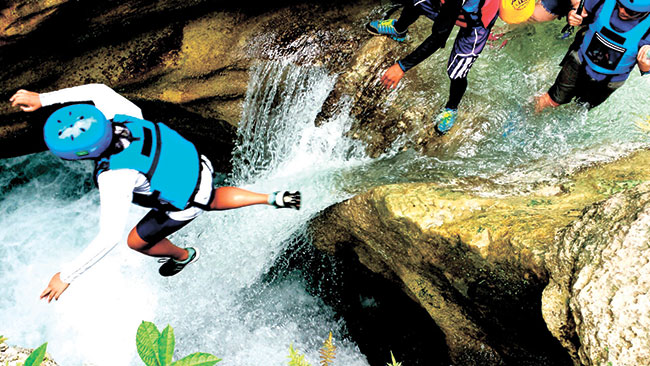Parks of the South
3 must-visit heritage sites in the southern towns of Cebu
Photos & Text by N.S. Villaflor
THE Southern towns of Cebu offer not just natural attractions such as countless waterfalls, breathtaking mountain sceneries, and the protected seascape of Tañon Strait, but heritage sites as well. Since a trip down south is inevitable this summer, check out three must-visit, easy to locate heritage sites to make make your trip worthwhile and let’s you appreciate history and the value of open space.

Oslob Heritage Park

Located some 120 kilometers from Cebu City is the sprawling Oslob Heritage Park, which faces the sea. Within the park are the Baluarte, Cuartel and the Immaculate Conception Parish Church, as well as a statue of “El Parroco Capitan” Fr. Julian Bermejo.
The Cuartel
Made of coral stones, the Cuartel served as barracks for Spanish armies, but construction was halted during the American occupation in 1899. The walls of the Cuartel are 19 centimeters thick.
The Baluarte
Built in 1788 on the coastline of Oslob, the seven-meter-tall hexagonal Baluarte is one of 12 watchtowers constructed in the southern town to defend against moro marauders. These baluartes devised by Fr. Bermejo stretched from Carcar town all the way to Santander, the southern tip of Cebu island.
Immaculate Conception Parish Church
Construction of the Immaculate Conception Parish Church began in 1830, with Fr. Bermejo choosing the site since it is suitable for a settlement. The church was hit by fire twice — in 1955 and then in 2008 — and was restored anew in December 2010.
Cabecera de Argao

A historical and cultural landmark in the south that shouldn’t be missed for a good stroll is the Cabecera de Argao, which used to be a fortified town or Spanish pueblo. Within the town center, now heritage park, is the Argao Parish Church, the Argao Hall of Justice and the Balay Lungsod sa Argao.
Argao Parish Church
Standing elegantly in the Cabecera de Argao Heritage Park, this Baroque Rococo church took 54 years to build: started in 1734 and finished in 1788. The church is currently undergoing restoration using traditional methods.
Argao Hall of Justice
The Argao Hall of Justice was built in the 1800s during the Spanish occupation within the town’s fortified walls in the pueblo. It features meter-thick coral stone walls, capiz windows and clay roof tiles. The Spanish cannon in the foreground is one of three canyons on display at the park. Brought some time between 1600 and 1700 during the Galleon trade, these canyons were used to defend against moro raiders.
Balay Lungsod sa Argao
Built in 1608, the well-ventilated Balay Lungsod sa Argao or municipal hall also serves as a museum of traditional Argaoanon implements. The structure, which carries Chinese elements, particularly the clay roof tile design, is typical of that period: the first level built of stone and wood supports the second level which is made of light materials.
Samboan Municipal Plaza

Samboan is famed for its breathtaking sunsets and the epic Aguinid Falls, but it’s also home to a well-kept heritage park at the town center. You won’t miss it as a huge sculpted sign that reads “Siempre Samboan” on a hillside along the highway would lead you to the park, which can be enjoyed at night after viewing the sunset.
Religious Sculptures
Inside the town plaza are beautiful life-size sculptures depicting the Stations of the Cross. Though Holy Week has just passed, the place still offers a solemn, if not awe-inspiring, experience, especially at night.
Campanario de Antigua
A Spanish structure made of coral stones, the Campanario de Antigua was built as a lookout against moro raiders. Erected on a coastal hill some 65 meters above sea level, the three-story watch tower is the tallest of its kind on the entire island and gives a commanding view of Tañon Strait. The restored watch tower is connected to the coast (now a highway road) by Escala de Jacobe, or Jacob’s Ladder, a flight of 147 stone steps.
San Miguel Archangel Church
Built 200 years ago, the Samboan Church or St. Michael Archangel Church has unique masonry and design features such as a bare facade and a single nave. The church is one of Cebu’s oldest Spanish buildings.
Where to Stay? — A southern farm resort for peace and quiet
WITH droves of staycationers descending at Cebu’s rural areas during the summer break, your vacation can become hectic instead of relaxing. But you can avoid this by planning your trip well, especially when it comes to accommodations.
So if you feel like going off the grid and getting away from it all, Palanas Farm and Resort offers modest but quiet and relaxing accommodations. Far from the madding coastal crowd, the resort is safely tucked in the mountains of Boljoon in southern Cebu, some 12 kilometers upland from the national highway. The relaxing drive along this stretch is a scenic one.
Named after flowers that line the gardens and pathways, the more than a dozen air-conditioned rooms and cottages of Palanas Farm and Resort offer homey, no-frills comfort that come with toiletries and mineral water. Rates range from P1,500 for a room for two guests to P7,500 for a cottage with kitchen for 15. Guests can cook their own food or make food arangements with management.
Intended as a vacation home in the 1990s by the Estella Family, Palanas Farm and Resort is a work in progress. To date it has four well-maintained and kid-friendly swimming pools. Beside the kiddie pool is the main pool area that has a two-level slide built in a nicely colored ship structure.
Apart from the pools (P350 fee for adults and P175 for kids), the resort has function rooms that can accommodate 20 to 100 persons, recreation areas, farms and gardens, among others. For activities, one can arrange trekking along the resort’s trails to commune with nature.
Those who wish for a serene mountain experience with the comforts of home may find a night or two at the resort rejuvinating. Bigger groups that aim for team-building or recollection sessions may find the right place for focus, introspection and soul-searching here. Except for the cable television, there is minimal connectivity at the resort so guests will know how liberating it can be to get off the grid for once.
Getting There
Palanas Farm and Resort, which is 119 kilometers from Cebu City, is located in Pondohan, Upper Becerril, a mountainous area 12 kilometers from the highway. Palanas offers car or van rentals with driver, but guests who opt for DIY travel can reach the resort by other means.
By Bus. Take a bus at the Cebu South Terminal in Cebu City and disembark at the Boljoon town proper. From there, you can request for a resort shuttle or take a habal-habal.
By Private Car. Drive to Boljoon along the main highway and watch for a big signboard that reads “Palanas By the Sea” to your left. To your right is an uphill road with a smaller sign that reads “Palanas Farm and Resort: 12 kilometers.” Take this road.
For inquiries, contact Palanas Farm and Resort at (032)520-5641 and 09228178598, or the sales and reservation office in Apas, Cebu City at (032) 231-2727 and 0927-4330213. You can email them at vrainbow_123@yahoo.com.



